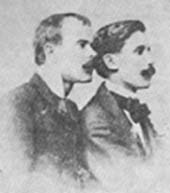3.1.6 The career of Federico Uhrbach (1873 – 1932) in poetry

Federico Uhrbarch, who sometimes wrote under the pseudonyms Tulio Arcos, Jorge Brummel, and René de Vinci, participated in modernism but was closer to French symbolism; although not so much in the aesthetic treatment of his verses, he did resemble Casal in a desolate worldview, in which his readings, the spirit of the times, and his personal circumstances coexisted.
Regarding his work, Jorge Yglesias says: “The main attraction that Federico Uhrbach may have for a contemporary reader is the fact that for several years he was our most distinguished lyricist. This does not mean that at a given time he was our best poet, but rather that other poets were not better than him. In reality, his work represents a rigidification of form, an unflagging fidelity to a literary movement—modernism—and to a writer: Julián del Casal.”
Both in Cuba and during his time as an exile in the United States, he generally published his texts in the same media outlets as his brother Carlos Pío. In fact, their lives and works followed very similar paths until Carlos’s death. Federico married Elena Borrero, the sister of Juana Borrero, his brother Carlos’s fiancée.
During the Republican era, he was a founding member of the National Academy of Arts and Letters and secretary of its Literature Section. His poetic work earned him praise and the admiration of his contemporaries; however, this work declined as the modernist aesthetic was surpassed.
In the poetry collection “Oro,” published in 1907, his works appear alongside those of his brother, without stating the individual authorship of each. Their poetics contributed to consolidating the modernist movement on the island and the legacy of Casal’s aesthetic.
In the case of Federico Uhrbach, this effectively adheres to Casalian modernist canons, but it did not have a notable intellectual or emotional content, although it did coincide with a moment of silence in Cuban lyric poetry, where even the political context determined an oppressive frustration on the collective spirit and modernist evasion was manifested in other social planes broader than literature itself.
In addition to the text “Oro”, he published or conceived other collections of poems that remained unpublished, among which are “Flores de hielo” (Ice Flowers), 1899, “Amor de ensueño” (Dream Love) and “Romanticism”, 1908, and “Resurrección” (Resurrection), from 1916, which constitutes, in Yglesias’ opinion, his moment of greatest poetic flight, beginning with the following sonnet:
Seed of hope
“Peace, deep peace, vast stillness, dream
in the sea, on the path, in the environment
twilight that makes sleep clear
of gold from the wheat fields of the west.
Peace, deep peace in my sadness,
and in my inner vision peace and charm,
expanding the golden distance
through the fog of my tears.
My heart, wounded in the fight,
melancholically along the path
from piety and life advances,
and in the infinite peace of the path
of all the chimeras pilgrim
“He dreams again, trembling with hope.”








